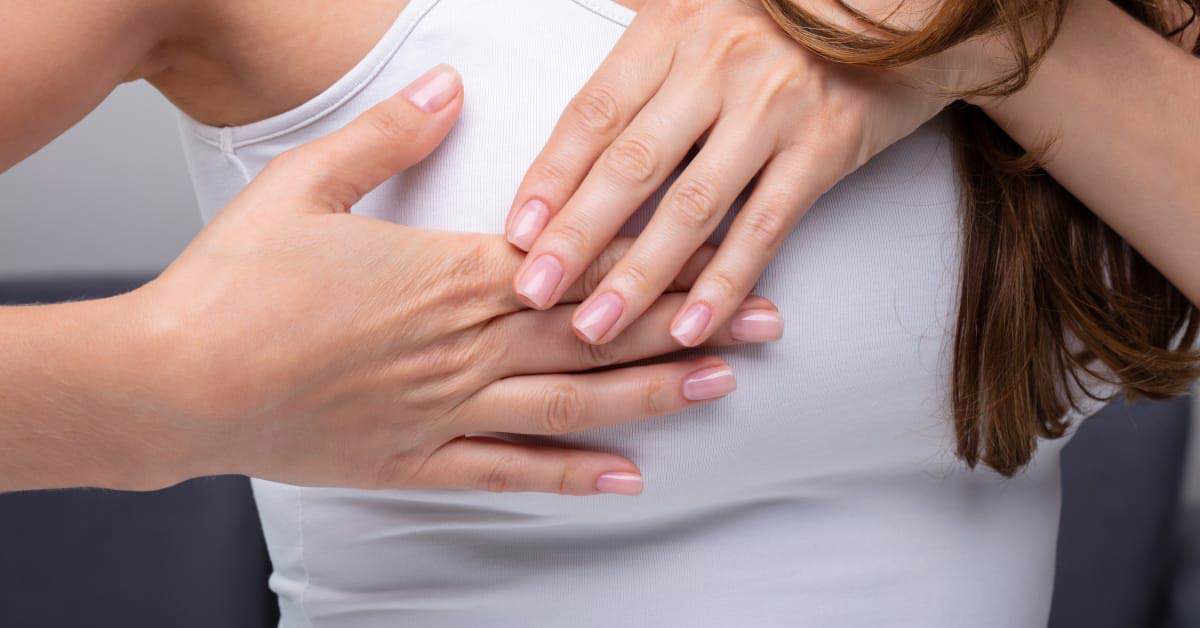
What Causes Breast Pain?
-
Updated: February 26, 2020
Pain is one of the most common breast symptoms prompting women to seek medical attention. However, contrary to its significance in most parts of the body, pain in the breasts is usually not a sign of a serious problem.
It most often represents sensitivity of normal breast tissue to dietary factors, medications, or hormonal changes. Mastalgia, or breast pain, can also arise from breast cysts, localized infections, or inflammation in the muscles or ribs behind the breasts, most of which can easily be identified and treated.
In the rare situation where pain is the result of breast cancer, it almost always occurs after the cancer has become obvious in other ways – such as a prominent breast lump or a visible change in the breast appearance. In summary, breast pain typically represents a challenge of symptom management, not a threat to life.
Most women are familiar with the cyclic pattern of breast pain and sensitivity related to the hormonal changes of the menstrual cycle. Symptoms often affect both breasts, but can affect one breast more than the other and generally increase in severity prior to a period. Usually the pain involves the whole breast, or one consistent area of the breast – often the upper, outer breast towards the armpit, or the central breast including the nipple. The pattern is familiar from month to month, and tends to resolve completely with the onset of menses.
Breast Pain Cause by Caffeine
Non-cyclic breast pain may be due to dietary triggers including caffeine, which is found in a variety of beverages and foods (coffee, tea, cola, chocolate) and may produce severe breast pain in some women with others experiencing no effect at all. Similar variable breast sensitivity has been associated with hormonal medications, some dietary supplements, and other foods including large amounts of dietary soy. Sometimes it is just not possible to isolate a specific cause, but in each of these situations the breasts are not the source of the problem; there is an external factor to which the breasts are sensitive, producing the discomfort.
If it is possible to identify and modify the trigger, the symptoms will be improved. In addition, a well-fitting supportive bra (ideally a sports bra), application of cool or warm compresses for comfort, and use of ibuprofen (or a similar mild analgesic with an anti-inflammatory effect) can be helpful in managing symptoms. It is important to understand that, because this type of breast pain relates to breast tissue sensitivity, it may be uncomfortable but is not harmful.
Breast Pain Caused by Cysts
Some breast pain does arise from the breast tissue itself and is often more localized than the type caused by sensitivity. An example would be pain from an inflamed or enlarging breast cyst. Cysts are fluid-filled spaces in the gland tissue of the breast and have no known cause, although they are almost always associated with some hormonal activity (women who are premenopausal or taking some type of estrogen/progesterone medication). Most cysts do not cause symptoms but, if the fluid is under pressure or if inflammation is present, the cyst may become tender and produce a lump. Ibuprofen and cool compresses will help, but aspiration of the fluid may be necessary to relieve the pressure and the pain. These cysts rarely recur after aspiration, but some women are prone to multiple cysts over time.
Costochondritis: The Most Common Cause of Breast Pain
Perhaps the most common cause of localized “breast pain” is costochondritis – inflammation in the ribs behind the breast. This may be due to increased physical activity or trauma, but often there is no known cause. The pain may be constant and achy or intermittent and sharp, but is always associated with tenderness over specific trigger points on the affected ribs, usually near the center of the chest. Because the pain is originating directly behind the breast, it often feels as though it is coming from the breast itself. This condition may resolve without treatment, but is similar to mild arthritis and can be treated with a short course of anti-inflammatory medication such as ibuprofen or naproxen.
Only rarely is breast pain the first symptom of a breast cancer, but a careful medical history, clinical breast exam, and updated breast imaging with mammography and ultrasound, when necessary, are always appropriate, particularly if there is no obvious explanation for the pain. A trial of symptom treatment is often successful even in the absence of a definite diagnosis, and most women will find a comfortable way to manage their symptoms even if they do not completely resolve. However, consultation with a breast specialist is indicated anytime there is an ongoing or specific breast concern.
Learn more about treatment for benign breast disease and breast cancer at Fox Chase.
